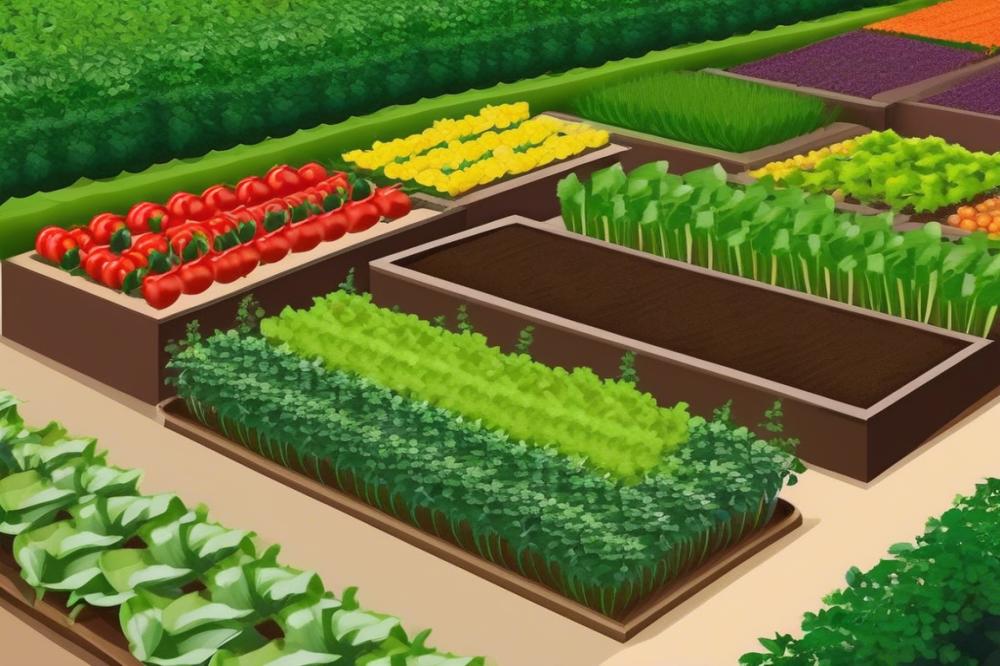The Role of crop rotation in Healthy vegetable gardens
crop rotation is a method where different types of crops are planted in the same area across different seasons. This practice is essential for maintaining soil health and supporting the overall ecosystem of a garden. There are numerous benefits to growing a healthy vegetable garden, and rotational planting plays a significant part in that process.
Healthy vegetable gardens thrive on various factors, including proper nutrient management and plant diversity. By changing plants each season, gardeners can prevent nutrient depletion. Different vegetables require different nutrients, which helps keep the soil balanced. This rotation reduces the need for synthetic fertilizers, making sustainable gardening more achievable.
Weed reduction is another advantage of changing crops regularly. Different plants compete with various weeds, making it harder for them to establish. pest control is enhanced too. Many pests are attracted to specific plants. When these plants are not present every year, pests have a harder time finding their food source.
Garden planning becomes easier when crop rotation is part of the strategy. It allows for succession planting, ensuring that the land is utilized efficiently throughout the growing season. Growing multiple crops helps achieve better crop yield overall. Organic farming practices benefit greatly from this method, as it aligns with their goals of sustainability and health.
Overall, the practice of crop rotation is a valuable technique for anyone interested in cultivating a thriving vegetable garden. It enhances soil health, manages nutrients effectively, and promotes plant diversity. Adopting this approach leads to a more joyful gardening experience while fostering an environment that sustains life.
Understanding Crop Rotation


Crop rotation involves changing the types of plants grown in a specific area over time. This practice has roots that stretch back to ancient agricultural societies. Farmers discovered long ago that growing the same crops in the same place year after year led to problems. Soil health declines, pests build up, and nutrients get depleted. By rotating crops, they could address these issues efficiently.
Different patterns play a role in successful garden planning. Some common methods include rotating by family, season, or using a four-year cycle. For instance, legumes like beans and peas can add nitrogen back to the soil. This benefits the next crops, such as tomatoes or lettuce, which need those nutrients. Other gardeners prefer to rotate crops based on their growth cycles, employing techniques like succession planting. Such methods help make the most of garden space and resources.
Pest control becomes more manageable with this approach. Certain crops can repel pests that harm others. A garden that includes a variety of plants is less likely to attract a single pest. Plant diversity is a key factor in keeping a healthy ecosystem. This method also helps reduce weeds. When the plants are diverse, it’s harder for weeds to establish a foothold.
Nutrient management is another critical aspect of crop rotation. Each type of plant has different nutrient needs. By changing what is grown, the soil can replenish certain nutrients, promoting robust plant growth. Sustainable gardening practices thrive on this principle, helping to create an environmentally friendly garden. Practicing this can also lead to improved crop yield over time.
As you plan your garden, think strategically about which plants will follow each other. Consider factors like sunlight, water, and nutrient preferences. Those planning a vegetable garden must consider how all elements work together. Organic farming often incorporates these practices. Doing so fosters a healthier garden, benefiting both plants and the gardeners who nurture them.
Soil Health and Nutrient Management


Crop rotation plays a vital role in improving soil health. Changing what you plant in a garden helps maintain a balanced soil ecosystem. Different plant families contribute to nutrient management in unique ways. For instance, legumes, such as beans and peas, fix nitrogen in the soil. This process enriches the ground for future crops that may need more nutrients. By rotating plants, you can prevent nutrient depletion that often leads to poor growth. Constantly planting the same vegetables can strip the soil of essential minerals.
Pest control also benefits from altering what is grown in specific spots. Pests and diseases tend to thrive on certain plants if they are planted continuously. When different crops are introduced, pests often lose their food source. This technique helps reduce reliance on chemical treatments, making gardening more aligned with organic farming principles. Additionally, plant diversity creates a healthier garden environment. More varied crops can invite beneficial insects and wildlife, enhancing overall garden resilience.
Weed reduction is another advantage of smart garden planning. Certain crops can shade the ground or compete with weeds, reducing their growth. This means less time spent weeding and more focus on enjoying your harvest. Including cover crops in your rotation can further boost benefits. These plants, like clover or rye, can be sown in the off-season. They prevent erosion, add organic matter, and suppress weed growth. Succession planting allows for continual use of your garden space while improving quality.
Improving soil health through thoughtful nutrient management produces better crop yields. Healthy soil can store water and nutrients more effectively. This leads to more robust plants that can withstand challenging weather conditions. By practicing sustainable gardening, you support the earth while enjoying fresh vegetables year after year. Rotating crops not only nourishes the soil but also cultivates a vibrant, thriving garden ecosystem.
Pest Control and Weed Reduction


Crop rotation acts as a natural shield against pests and diseases. By changing the types of plants grown in a specific area over time, we can disrupt the life cycles of harmful insects. Many pests thrive on specific crops. When these crops are replaced with others that they don’t prefer, their populations dwindle. This simple practice offers an effective approach to pest control without relying on harsh chemicals.
Fungi and bacteria can also become problematic in gardens. Growing the same crop repeatedly increases the chances of soil-borne diseases. Changing plants each season reduces the risk. Different crops have different strengths and weaknesses against pests and pathogens. A varied diet for the soil keeps it healthy and resilient.
Plant diversity is key in sustainable gardening. Integrating a variety of vegetables helps in weed reduction as well. Different plants compete for resources, leaving less room for unwanted weeds to thrive. Moreover, some crops shade the soil, hindering weed growth. Succession planting can amplify this effect. As one crop finishes, another can take its place, keeping the ground covered and reducing weed pressure.
Using these strategies can lead to increased crop yield over time. A healthy garden thrives when pests and diseases are kept in check. Soil health and pest control go hand in hand. Organic farming methods benefit significantly from these practices. Thoughtful garden planning allows for a more Biodiverse ecosystem. Overall, the impact of rotating crops goes beyond simple vegetable production. It creates a thriving environment where plants can flourish, pests are kept at bay, and weeds are managed effectively.
Enhancing Crop Yield and Plant Diversity


Crop rotation is a strategy that many successful gardeners embrace. This practice can lead to impressive increases in crop yield. By varying the types of vegetables grown in specific areas, farmers can optimize soil health. Some plants remove certain nutrients while others replenish them. As a result, the ground retains its richness, promoting healthier growth.
Plant diversity is crucial. A garden filled with a variety of crops strengthens ecosystems. Different plants attract various beneficial insects, which can help control pests naturally. This mix reduces the need for harmful pesticides in organic farming. When pests are kept at bay, overall plant health improves. This contributes to vibrant, productive gardens.
Weed reduction is another advantage of a diverse planting scheme. Some crops can out-compete weeds, minimizing the struggle for resources. This means gardeners spend less time weeding and more time enjoying their harvest. Moreover, diverse plant life creates habitats for wildlife and enhances overall garden resilience.
Succession planting plays an essential role alongside varied planting. As one crop finishes, another can take its place efficiently. This method maximizes space and time, allowing gardeners to make the most of every season. Combining succession planting with proper garden planning creates a sustainable approach to growing food.
Nutrient management is vital for strong crops. When plants alternate, they each contribute differently to the soil. Legumes, for instance, can fix nitrogen, benefiting the following crops. Such practices create a cycle of growth that keeps the soil fertile and productive.
By implementing these strategies, gardeners can experience the full benefits of both enhanced crop yield and plant diversity. It’s a win-win situation for those looking to cultivate a thriving, healthy vegetable garden.
Crop Rotation in Organic Farming
Organic farming thrives on principles that enhance soil health and promote biodiversity. Gardeners often utilize a practice that involves alternating the types of crops grown in a particular area. This method helps maintain nutrient management while bolstering the ecosystem of the garden.
In organic gardens, rotating plants not only improves the fertility of the soil but also supports pest control. Different plants attract various insects and wildlife, providing natural pest deterrents. For instance, planting legumes like beans after growing heavy feeders such as tomatoes can replenish nitrogen levels in the soil.
Another benefit lies in reducing weeds. Growing different crops in succession prevents any one species from dominating the area. This practice disrupts the life cycles of weeds, making it harder for them to establish themselves. Hence, organic gardeners can enjoy a cleaner, more manageable growing space.
A well-planned rotation enhances crop yield. By selecting compatible plant families, such as the sun-loving brassicas like kale and the shade-tolerant root vegetables like carrots, growers can maximize their garden’s potential. Additionally, incorporating cover crops during off-seasons enriches the soil and prevents erosion.
Succession planting becomes easier with a strategic approach to crop alternatives. For example, following spring greens with summer squash allows gardeners to make the most of their growing season. Each crop contributes differently, ensuring that the land never goes unused and remains productive.
Focusing on plant diversity plays a crucial role in this method. Diverse plantings can hinder the spread of plant diseases and promote a thriving habitat for beneficial organisms. Consequently, organic growers create a more resilient ecosystem, which benefits the garden overall.
Moreover, successful crop rotation strategies reflect the wisdom of sustainable gardening. Farmers may implement a cycle of root crops, followed by legumes, and then leafy greens. Each step in the rotation is a thoughtful move aimed at nurturing the soil while providing a bountiful harvest.
In summary, every choice in an organic garden matters. The way crops are organized can lead to healthier soil, effective pest control, and smarter use of resources. This approach is not just practical; it aligns with the values of those dedicated to sustainable practices.
Bringing It All Together
Vegetable gardening thrives through various practices, and one standout method shines brighter than the rest. Employing crop rotation can drastically improve your garden’s productivity. This practice helps maintain soil health, leading to stronger, happier plants. When you switch out different crops, each plant contributes uniquely to the ecosystem of your garden. This diversity can decrease the buildup of pests and diseases, making pest control more manageable.
Another significant advantage lies in nutrient management. Different vegetables absorb different nutrients from the soil. By rotating them, you can prevent soil depletion and promote a balanced nutrient profile. This means healthier plants and, in turn, better yields. Additionally, planting different crops can increase the resilience of your garden against adverse conditions.
A sustainable approach requires us to integrate smart practices like this into our routine. Relying on one type of vegetable year after year may limit the garden’s potential. Take action to diversify your planting schedule. Each season presents an opportunity to enhance your garden’s health and productivity.
By embracing these strategies, you not only contribute to your garden’s success but also create a more sustainable environment. So, why not start today? Implement crop rotation in your gardening practice and watch your garden flourish.



